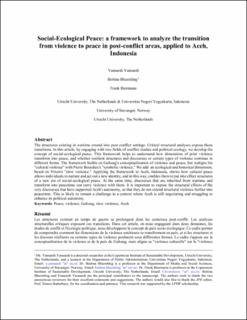| dc.contributor.author | Yanuardi, Yanuardi | |
| dc.contributor.author | Bluemling, Bettina | |
| dc.contributor.author | Biermann, Frank | |
| dc.coverage.spatial | Indonesia, Aceh | en_US |
| dc.date.accessioned | 2022-07-13T13:28:52Z | |
| dc.date.available | 2022-07-13T13:28:52Z | |
| dc.date.created | 2022-04-02T09:08:06Z | |
| dc.date.issued | 2021 | |
| dc.identifier.citation | Social-Ecological Peace – A framework to analyze the transition from violence to peace in post-conflict areas, applied to Aceh, Indonesia. Journal of Political Ecology, 29(1), 247–265 | en_US |
| dc.identifier.issn | 1073-0451 | |
| dc.identifier.uri | https://hdl.handle.net/11250/3005094 | |
| dc.description.abstract | While the analysis of peace often stops with "negative peace" in conflict studies (Shields 2017), critical structural analyses of a transition towards peace risk to analytically emphasize how wartime structures extend into post-conflict times (see e.g. Lee 2020). In this article, by engaging with the two fields of conflict studies and political ecology, a framework is developed that allows a critical analysis of resilient structures and discourses from times of conflict, as well as of possible leverage points that could support a transition towards what is here conceptualized as "social ecological peace". The framework hence helps to understand in how far dimensions of prior violence have transformed into peace, and if certain dimensions of violence have continued, even though they manifest themselves in a different way. The framework builds on Galtung’s conceptualization of violence and peace, but realigns "cultural violence" with Pierre Bourdieu's "symbolic violence". Additionally, for extending the framework with an ecological dimension and historical dimension, the notion of 'slow violence' by Rob Nixon is introduced. Applying the framework to Aceh, Indonesia, shows how cultural peace allows individuals to narrate and act out of a new identity, and in this way, enables them to put into effect structures of a new era of positive social-ecological peace. At the same time, discourses that are inherited from wartime and transform into peace time structures risk to carry violence in them. It becomes important to lay open the structural effects of the very discourses that have supported Aceh’s autonomy, so that they may not further extend structural violence into peace times. This is likely to remain a challenge in a context that is described as still negotiating and struggling to enhance its autonomy (Setyowati 2020a). | en_US |
| dc.language.iso | eng | en_US |
| dc.publisher | University of Arizona Libraries | en_US |
| dc.rights | Navngivelse 4.0 Internasjonal | * |
| dc.rights.uri | http://creativecommons.org/licenses/by/4.0/deed.no | * |
| dc.subject | fred | en_US |
| dc.subject | vold | en_US |
| dc.subject | Galtung | en_US |
| dc.title | Social-Ecological Peace – A framework to analyze the transition from violence to peace in post-conflict areas, applied to Aceh, Indonesia | en_US |
| dc.type | Peer reviewed | en_US |
| dc.type | Journal article | en_US |
| dc.description.version | publishedVersion | en_US |
| dc.subject.nsi | VDP::Samfunnsvitenskap: 200::Sosiologi: 220 | en_US |
| dc.source.pagenumber | 247–265 | en_US |
| dc.source.volume | 29 | en_US |
| dc.source.journal | Journal of political ecology | en_US |
| dc.source.issue | 1 | en_US |
| dc.identifier.doi | 10.2458/jpe.4707 | |
| dc.identifier.cristin | 2014763 | |
| cristin.ispublished | false | |
| cristin.fulltext | original | |
| cristin.qualitycode | 1 | |

